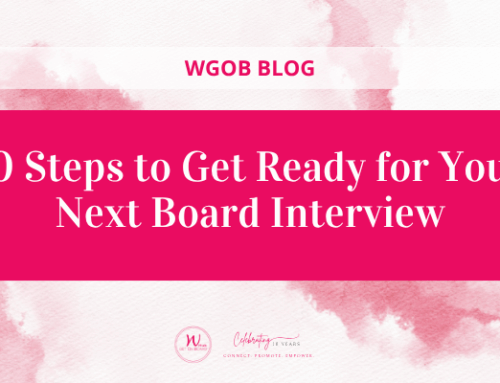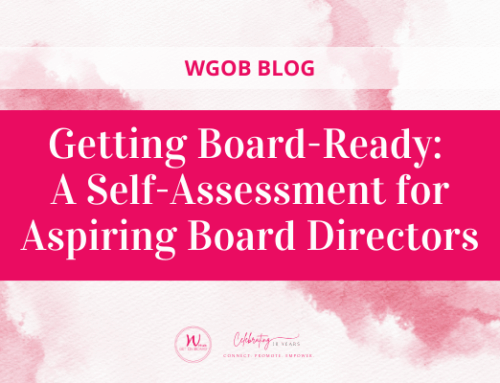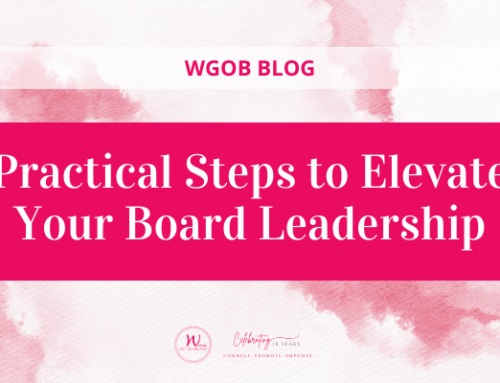Women Get On Board Inc. (WGOB) is a member-based company that connects, promotes and empowers women to corporate boards. On May 11th, we held our virtual WGOB Virtual Speaker Series sponsored by DirectorPrep.com. This virtual event featured a digital fireside chat about Brian Hayward’s new book, The Great Chair.
Deborah Rosati, FCPA, FCA, ICD.D, Corporate Director, Founder, and CEO of WGOB, kicked off the panel by introducing interviewer Scott Baldwin, Co-Founder of DirectorPrep.com. Throughout his career as a certified board director and his work at DirectorPrep.com, Scott has gained critical insights on governance for private companies and non-profit boards.
Scott introduced Brian Hayward, President of Aldare Resources and author of The Great Chair, an insightful take on effective board governance and the importance of strong board chairs. With nearly four decades of experience governing organizations, Brian brought practical advice and insights for board members—especially chairs.
It is well understood that a great chair makes for a better board. But what are the qualities of a great chair? What is their role on the board, and how do they execute that role effectively to get the most out of the board’s members?
None of these questions have easy answers, but thankfully, Brian has literally written the book on the topic. This fireside chat with Brian was a valuable opportunity to learn more about effective board chairs.
Can anyone become a board chair?
People often tend to see the role of the board chair as a box ticker or a timekeeper.
“That kind of chairing? I think anyone can do it,” said Brian.
However, being a great board chair is about more than keeping time and setting the agenda. The best board chairs understand what the organization is all about, the critical issues, and what risk factors exist. They are responsible for understanding what is essential to the group and ensuring that the discussion is fruitful, meaningful and engaging.
Brian pointed out that great chairs understand how to get the most out of people. In a well-managed meeting, the chair should take care to ensure that the quietest members of the group have the opportunity to speak and all directors feel comfortable expressing their thoughts.
What sets a great chair apart?
Three qualities set a great chair apart from the rest. First and foremost, Brian emphasizes that the board chair must own the agenda.
“Make sure that when you’re sitting there, you’re very focused on what the discussion is going to be about,” said Brian.
Secondly, trust is crucial. Board leaders should aim to foster and grow trust between members of the board and executives.
And thirdly, Brian believes that a great chair should prioritize their own personal and professional development to ensure that they continue to perform at their best. In his own career, Brian likes to pursue purposeful learning opportunities, deliberate0. and fun (‘PDF’ for short). After all, he knows that when he is at his best, he will serve others better.
How do you become a board chair?
To start your chairing journey, do not wait to be asked. Instead, step up and make it known that you are interested in taking a leadership role.
If you’re worried that you’re not prepared, don’t let that deter you. Brian said that the only way to learn is to simply start chairing.
“Think of it like riding a bicycle or playing a guitar or water-skiing,” said Brian. “You can’t read it in a book. You don’t know what it is until you get into that mode.”
How do effective board chairs engage their colleagues to reach consensus?
When board members disagree on an issue, it is the chair’s role to help them find alignment and reach a consensus.
To reach an agreement, treat the board meeting like a negotiation. That means separating the people from the problem, asking helpful questions that get to the root of the issue, and brainstorming solutions together. Once you have many possible solutions on the table, you can work together to align divergent opinions and determine the best decision for the organization moving forward
But how do you convince people with opposing opinions to come to an agreement? As Brian explained, it all comes back to trust. If all parties believe that the chair has their best interests—and the company’s best interests—at heart, consensus will follow.
Vulnerability is also vital. In a board meeting, being vulnerable may not mean sharing heartfelt conversations about your childhoods. Instead, it could involve giving away some information about yourself in a way that builds trust and understanding.
How do you set an effective agenda?
Too often, boards get caught up on minor issues and do not dedicate sufficient time to the important ones. Board chairs can put a stop to that problem by setting a solid agenda and sticking to it.
A good agenda should have what Brian calls “SPF 50.” At least 50 percent of the meeting should be dedicated to issues that are related to strategy, people, or finance.
“Don’t let the other stuff that gets piled in the shopping cart clutter up the agenda,” said Brian.
He suggests compiling the less important administrative issues—like who signs the cheques—and getting them out of the way at the beginning of the meeting.
How do you enhance your relationship with other directors and the CEO?
As the chair, you are responsible for developing and sustaining strong relationships with the board members and the C-suite.
When working with a CEO, vulnerability and honest communication are critical. When the chair encourages openness and candid conversation together, the result will be a relationship in which both the chair and the CEO work in sync and feel safe sharing information.
To earn the trust of peer directors, the chair should focus on operating with integrity and professionalism. Additionally, the chair should ensure they have their finger on the pulse of the organization. When directors have confidence that the chair is informed about the issues facing the company, they will be more likely to trust his or her decisions.
Brian’s advice provides an excellent foundation to help any budding board chair. However, Brian also emphasized that board members can only learn so much about chairing from a book or a webinar. At the end of the day, great chairs learn by doing.
“Get in the chair and do it,” said Brian. “Doing it is the best experience.”
As part of the journey, you will make mistakes. The key is to learn from them. As a new chair, ask for feedback about your performance; you should take it in and adjust? Before long, you will be on the path to becoming a truly great chair.
Are you interested in learning more about effective boards and governance? Join us for our next virtual WGOB Speaker Series on September 14th called “Getting Climate Change on the Board Agenda: Directors share their strategies,” a moderated panel discussion sponsored by the Canada Climate Law Initiative. Register here.







